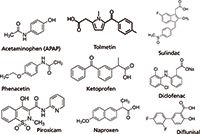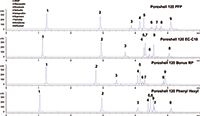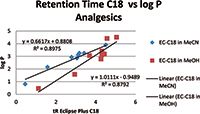Fast Screening Methods for Analgesics and Non-Steroidal Anti-Inflammatory (NSAIDS) Drugs by HPLC with Agilent Poroshell 120 Columns
Selectivity is the most powerful tool to optimize separations in HPLC. This parameter is changed by using different bonded phases, including C18, polar embedded, phenyl bonded phases and perflorophenyl, or by changing the mobile phase. In this work, 4.6 ? 50 mm Poroshell 120 columns are used to quickly evaluate method development choices for the analysis of non-steroidal anti-inflammatory drugs (NSAIDS).
Using Selectivity to Enhance Separation of Analgesics
Selectivity is the most powerful tool to optimize separations in HPLC. This parameter is changed by using different bonded phases, including C18, polar embedded, phenyl bonded phases and perflorophenyl, or by changing the mobile phase. In this work, 4.6 × 50 mm Poroshell 120 columns are used to quickly evaluate method development choices for the analysis of non-steroidal anti-inflammatory drugs (NSAIDS). The short column length and high efficiency provide short analysis times and rapid equilibration, leading to fast investigations of selectivity.
Experimental Conditions
Instrument: Agilent 1260 Infinity Binary LC System
Columns: Noted below
Flow rate: 2 mL/min
Mobile Phase: A: 20 mM NH4HCO2pH 3.0 B: Acetonitrile
Temperature: 40 °C
Detection: UV, 254 nm
Gradient:
Time % Organic
0 8
6 100
7 100
8 8
The Agilent 1260 Infinity Binary LC System was configured as follows:
- G1312B Binary Pump SL, capable of delivering up to 600 bar
- G1316C Thermostatted Column Compartment (TCC)
- G1376D High Performance Autosampler SL Plus
- G4212A Diode Array Detector equipped with a G4212-60008 10 mm path length, 1 µL volume flow cell
The following columns were used in this study.
- Agilent Poroshell 120 PFP, 4.6 × 50 mm, 2.7 µm (p/n 699975-408)
- Agilent Poroshell 120 EC-C18, 4.6 × 50 mm, 2.7 µm (p/n 699975-902)
- Agilent Poroshell 120 Bonus-RP, 4.6 × 50 mm, 2.7 µm (p/n 699968-901)
- Agilent Poroshell 120 Phenyl-Hexyl, 4.6 × 50 mm, 2.7 µm (p/n 699975-912)
A generic gradient separation was used to evaluate these columns consisting of ammonium formate (20 mM NH4HCO3pH 3.0) using either methanol or acetonitrile.

Table I: Retention time, Log P, and pKa data for selected analgesics
The analgesic materials all possess a wide variety of functional groups including fluorine (sulindac and diflunisal) and chlorine (diclofenac). The structures of the compounds examined are shown in Figure 1 and Table I. All samples were prepared at 10 mg/mL in acetonitrile and were diluted in water to a final concentration of 0.1 mg/mL.

Figure 1: Structures of selected analgesics.
Column Choice to Enhance Selectivity
The columns were chosen to improve selectivity in the separation. They included a highly end capped C18 column recommended as a first choice in method development (Poroshell120 EC- C18).

Figure 2: Separation of analgesics using Agilent Poroshell 120 columns using methanol.
Poroshell 120 Bonus-RP can be used for many of the same separations as a C18 column while avoiding some of the disadvantages of C18, such as poor wettability in high aqueous mobile phases. In addition, it is much more retentive for those molecules that can interact by hydrophobic interactions and also by H-bonding with the amide group. Compared to alkyl only phases, Bonus-RP has enhanced retention and selectivity for phenols, organic acids, and other polar solutes due to strong H-bonding between polar group (H-bond acceptor) and H-bond donors, like phenols and acids. Bonus-RP gives retention slightly less than a C18 allows, for easy column comparison without the need to change mobile phase conditions. The Bonus-RP phase gives different selectivity than C18 for polar compounds. It is also compatible with 100% water.
Poroshell 120 Phenyl-Hexyl columns deliver unique selectivity for compounds with aromatic groups, providing superior resolution for these samples. Poroshell 120 Phenyl-Hexyl can also provide optimum separations of moderately polar compounds where typical alkyl phases (C18 and C8) do not provide adequate resolution. Acetonitrile tends to decrease the π–π interactions between aromatic and polarizable analytes and the phenyl-hexyl stationary phases, but methanol enhances those same interactions, giving both increased retention and changes in selectivity. This does not mean that acetonitrile should not be used with a phenyl bonded phase or that it might not provide an acceptable separation, but methanol is more likely to deliver the different selectivity that is desired from a phenyl phase.
Poroshell 120 PFP columns possess a pentafluorophenyl ligand. This can provide an orthogonal separation mechanism to traditional reverse phase columns. By specifically targeting many polar retention mechanisms, PFP phases can separate analytes based on small differences in structure, substitution, and steric access to polar moieties. The resulting selectivity for positional isomers, halogenated compounds, and polar analytes is particularly useful in the analysis of complex mixtures, and small molecule pharmaceuticals
Results and Discussion
The separation of all nine compounds was attempted on all columns surveyed. The Poroshell 120 PFP and Poroshell 120 Bonus RP columns both fully resolved all compounds in the same order, although the spacing of the peaks is more even on PFP. The Poroshell 120 Phenyl Hexyl column does not yield the same elution order as the Poroshell 120 PFP column. This means that the PFP column is not just a stronger phenyl column, other interactions beside π-π and hydrophobic interactions are in play. All four columns elute acetominophen (APAP) and phenacetin first. The Poroshell 120 EC-C18 column did not fully separate three compounds (Tolmetin, Ketoprofen, and Sulindac).

Figure 3: Separation of analgesics using Agilent Poroshell 120 columns with acetonitrile.
Figure 3 shows the separation on all four columns using acetonitrile. In this case, only Poroshell 120 PFP resolves all compounds, and Poroshell 120 EC-C18 and Poroshell Phenyl Hexyl columns elute all compounds in the same order. Typically π-π interactions with Phenyl Hexyl columns are overwhelmed in acetonitrile. Again, the PFP and Bonus RP Columns have very similar elution orders (with the exception of the last two peaks).
Since the Poroshell 120 PFP phase almost separates all nine compounds when using methanol or acetonitrile, it provides the best method development option for further development.

Figure 4: Poroshell 120 EC-C18 retention time vs. log P values.
Table I lists the retention time of all nine analytes on the four columns using both methanol and acetonitrile. Log P and pKa data are also listed. The Log P refers to the equilibrium distribution of a single substance between two solvent phases separated by a boundary. It was discovered that the narcotic action of many simple organic solutes was reflected rather closely by their oil-water partition coefficients. The oil was later replaced by octanol (5). In Figure 4, Log P values correspond to retention time on the Poroshell 120 EC-C18 column using methanol or acetonitrile. Figure 5 shows the correlation of Poroshell EC-C18 and PFP retention time data in methanol and acetonitrile for the last seven analgesics. The first two analgesics, acetominophen and phenacetin, remain in the same elution order in all solvent column combinations. With these compounds removed, the correlation between EC-C18 and PFP retention in methanol (5a) and acetonitrile (5b) is poor and highly indicative of orthogonality.

Figure 5: Poroshell 120 EC-C18 retention time vs. Poroshell 120 PFP retention time.
Conclusions
Analysis problems can be quickly resolved by including survey methods with generic gradients as part of the method development scheme. This work demonstrates how different chemistries and organic modifiers such as acetonitrile and methanol can develop different selectivity and can be used to optimize the separation. In this case, using an alternative selectivity column such as Poroshell 120 PFP yielded better results than a more commonly used C18 chemistry. Fluorinated stationary phases are useful because of their enhanced interaction with halogens, and conjugated compounds.
References
(1) A. Streitweiser Jr. and C.H. Heathcock, Introduction to Organic Chemistry, (MacMillan, New York, 1981).
(2) http://en.wikipedia.org/wiki/Non-steroidal_anti-inflammatory_drug.
(3) J. Sangster, "Logkow: A Database of Evaluated Octanol/Water Partition Coefficents," (Log P), http://logkow.cisti.nrc.ca/logkow/index.jsp.

Agilent Technologies
2850 Centerville Road, Wilmington, DE 19808
Website: www.agilent.com/discoverporoshell

SEC-MALS of Antibody Therapeutics—A Robust Method for In-Depth Sample Characterization
June 1st 2022Monoclonal antibodies (mAbs) are effective therapeutics for cancers, auto-immune diseases, viral infections, and other diseases. Recent developments in antibody therapeutics aim to add more specific binding regions (bi- and multi-specificity) to increase their effectiveness and/or to downsize the molecule to the specific binding regions (for example, scFv or Fab fragment) to achieve better penetration of the tissue. As the molecule gets more complex, the possible high and low molecular weight (H/LMW) impurities become more complex, too. In order to accurately analyze the various species, more advanced detection than ultraviolet (UV) is required to characterize a mAb sample.















